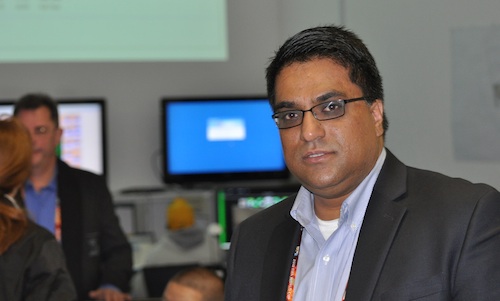
Computers operate better in cold conditions. That’s a good thing, because when TechCentral paid a visit to Fifa’s IT command centre for the 2010 World Cup at Nasrec, outside Soweto, on Wednesday this week, the winter air was arctic.
The command centre, located next to the International Broadcast Centre, consists of several dozen engineers and technicians manning computers and keeping a watchful eye on giant images projected onto the wall.
At a glance, Fifa’s IT partner, India’s Mahindra Satyam, can monitor the state of the World Cup networks and technology infrastructure — from network traffic volumes at the stadiums, right down to individual printers and workstations. If something goes wrong, the command centre knows about it almost immediately and can act.
The man in charge of keeping it all together for the duration of the tournament is Dilbagh Gill, Mahindra Satyam’s head of sports business. Gill is also responsible for the company’s relationship with Fifa.
Mahindra Satyam started working with Fifa in March 2007, developing the world football governing body’s event management system. It’s now Fifa’s official IT partner.
Developing and managing the IT systems for an event of the scale of the World Cup is not easy, Gill says.
“We have developed this all from scratch, with about 300 man years of development having gone into this,” he says. “We had to design a piece of software that is immensely robust and scalable but that is also easy to use.”

For the first time in a World Cup tournament, the IT systems are largely “cloud-based” — the applications reside on giant servers and are accessed over the Internet.
“This is the first major sporting event that is running on a Web-based solution,” says Gill. “We literally moved a lot of the software into the cloud.”
The IT systems are hosted in data centres operated by Telkom, with back-up facilities in Europe and US. “The primary data centre is here in SA as most of the users are here for the event,” Gill says.
He says the 2010 World Cup is much more technologically advanced than the 2006 event, which was held in Germany. “That was still very much a client-service environment,” he says.
The scale of the system for this year’s World Cup is enormous. The event management system alone has to accredit nearly 250 000 people, compared to 160 000 in 2006. This includes media, Fifa officials, players, team managers and support staff, as well of 130 000 volunteers, many of whom will receive stipends.
“The system manages payroll details and attendance and is all done electronically,” Gill says.
About 1 000 vehicles, including cars and buses, are also all managed electronically. If someone requests transport, they are immediately sent an SMS notifying them where a car will be to fetch them and at what time.
The system also has to manage US$1bn of assets that have been deployed around the country for the duration of the tournament. “We have to ensure deployment is done right and that the products then go back to the right places after the World Cup.”
Mahindra Satyam has detailed computer drawings of every stadium, and details of which equipment has to be deployed where and when. “The software maps the physical and logical views and … generates drawings of how this equipment needs to be deployed,” Gill says. “Soccer City might have 3 000 journalists attending a game, so we have to make sure the media room has sufficient Internet connections and plug points and that the space is big enough.”
The company has 130 full-time IT engineers and other technical staff supporting the World Cup. They’re spread across the 12 venues: the 10 stadiums, the IT command centre and adjoining International Broadcast Centre, and the Fifa headquarters in Sandton.
Gill says the IT systems developed for the 2010 event will also be used in the 2014 World Cup in Brazil, as well as at all 20-plus Fifa events between now and then. — Duncan McLeod, TechCentral
- Subscribe to our free daily newsletter
- Follow us on Twitter or on Facebook




